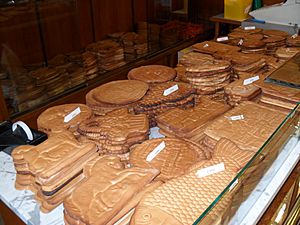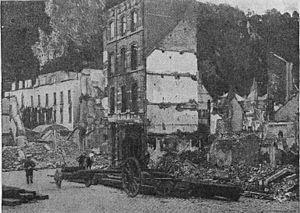Dinant facts for kids
Quick facts for kids
Dinant
|
|||
|---|---|---|---|

The citadel, the collegiate church and the Meuse
|
|||
|
|||
| Country | Belgium | ||
| Community | French Community | ||
| Region | Wallonia | ||
| Province | Namur | ||
| Arrondissement | Dinant | ||
| Area | |||
| • Total | 99.80 km2 (38.53 sq mi) | ||
| Population
(2018-01-01)Lua error in Module:Wd at line 1575: attempt to index field 'wikibase' (a nil value).
|
|||
| • Total | Lua error in Module:Wd at line 1,575: attempt to index field 'wikibase' (a nil value). | ||
| Postal codes |
5500, 5501, 5502, 5503, 5504
|
||
| Area codes | 082 | ||
| Website | www.dinant.be | ||
Dinant is a historic city and municipality in Wallonia, a region in Belgium. It's located in the province of Namur. You can find Dinant right on the banks of the Meuse River, surrounded by the beautiful Ardennes area.
The city is about 90 kilometers (56 miles) south-east of Brussels, the capital of Belgium. It's also close to the border with France, about 20 kilometers (12 miles) north of it. The municipality of Dinant includes several smaller areas called districts, such as Anseremme, Bouvignes-sur-Meuse, and Dinant itself.
Contents
Geography of Dinant
Dinant is built in a very special place. The Meuse River flows through a deep valley here, cutting into the land. This means the city is squeezed between tall rock faces and the river. Because there wasn't much space to grow outwards, Dinant became a long, thin town stretching along the river.
The area around Dinant has rich farmland on the plateaus above the city. This helped the city grow. Dinant is also famous for its traditional crafts, especially making things from brass. This was easy because the wide river helped bring in raw materials and send out the finished products. Another important resource was the limestone cliffs. They provided high-quality stone like black marble and bluestone, which were also easily transported by the river.
History of Dinant
Early Days to the 10th Century
The name Dinant comes from an old Celtic word, Divo-Nanto. This means "Sacred Valley" or "Divine Valley." It could also mean "Celestial Gorge" or "Luminous Gorge."
People have lived in the Dinant area since ancient times, including the Neolithic period, Celts, and Romans. Dinant was first mentioned as a settlement in the 7th century. At that time, a bishop named Perpète moved his main home to Dinant and started a church there.
In the 11th century, the emperor Henry IV gave special rights to Dinant. These rights included holding markets and having its own justice system. From then on, Dinant became one of the 23 "good cities" of the Prince-Bishopric of Liège. A stone bridge was built over the Meuse River, and the castle was repaired around this time. For many centuries, Dinant's history was closely tied to Liège, sometimes fighting against it, and sometimes joining its battles.
The Late Middle Ages
Because Dinant was in a very important spot on the Meuse River, it often saw battles and was sometimes attacked. In 1466, a very sad event happened. Philip the Good, Duke of Burgundy and his son Charles the Bold punished an uprising in Dinant. They threw 800 citizens into the Meuse River and set the city on fire. Dinant also had an economic rival, Bouvignes, which was another town just downriver.
During the late Middle Ages, Dinant and Bouvignes were known for their metalwork. They made beautiful objects from a shiny brass alloy called dinanderie. These items included things like aquamaniles (fancy water pitchers), candlesticks, and other church items. These beautiful pieces were sent all over the Meuse valley and beyond.
Later History and World War I
In the 16th and 17th centuries, Dinant suffered a lot from wars between France and Spain. There was destruction, hunger, and sickness, even though the city tried to stay neutral. In 1675, the French army took over the city. Later, in the late 18th century, the Austrians briefly took control. Eventually, the whole area became part of France in 1795.
The old brassware style, dinanderies, went out of fashion. The city's economy then focused on making leather and playing cards. This was also when the famous couques de Dinant biscuits first appeared.
Dinant faced terrible destruction again at the start of the First World War. On August 15, 1914, French and German soldiers fought in the Battle of Dinant. A young soldier named Charles de Gaulle, who would later become a famous French leader, was wounded here. A few days later, on August 23, a very sad event occurred. Saxon troops from the German Army executed 674 people in Dinant. This was one of the biggest massacres by the Germans in 1914.
World War II
During World War II, Dinant was captured by German forces again. This happened during the Invasion of Belgium in May 1940. German forces, led by Erwin Rommel, took the town after crossing the Meuse River and defeating the French defenders.
Cool Places to See in Dinant
- The most famous building in Dinant is the Collegiate Church of Notre Dame de Dinant. It was rebuilt in the beautiful Gothic style after parts of the old church were destroyed by falling rocks in 1227. It has a unique central tower with a famous onion-shaped dome.
- Right above the church, you'll see the huge rock face with the Citadel of Dinant on top. This fortress was first built in the 11th century to control the Meuse valley. It was rebuilt many times. Today, you can climb 408 steps carved into the rock to reach it, or take a cable car during the busy season!
- Near the main part of the city is the Rocher Bayard. This is a tall, narrow rock that looks like it's been split in half. Legend says it was split by the giant hoof of Bayard, a magical horse from an old story. In reality, soldiers of Louis XIV split the rock to build a road next to the Meuse River.
- You can visit the house of Adolphe Sax, the amazing inventor of the saxophone. It's on a street named after him. There's a small museum called the Mr Sax's House that tells you all about his life and his inventions.
- Just a short distance south-west of Dinant, you can explore the Grotte de Dinant La Merveilleuse. This is a series of caves with amazing stalagmite and stalactite formations.
Tasty Treats from Dinant

- The Flamiche dinantaise is a local dish. It's like a quiche but made with a special cheese called "boulette de Romedenne."
- The couque de Dinant is known as Europe's hardest biscuit! It's sweetened with honey and has cool designs pressed into it from carved wooden molds before it's baked.
- The famous Leffe beer brand started in Dinant. There's even a museum there where you can learn about its history.
Getting Around
Dinant has a train station on the left bank of the river. You can catch a train to Brussels about once an hour, and the ride takes around 90 minutes.
Famous People from Dinant
Many interesting people have come from Dinant:
- Joachim Patinir (1485–1524) was one of the first painters to specialize in landscapes.
- Antoine Joseph Wiertz (19th century) was a well-known painter.
- Adolphe Sax (19th century) was the brilliant inventor of the saxophone and Saxtuba.
- Georges Pire was a priest who won the Nobel Peace Prize in 1958 for his work helping refugees.
- André Buzin (20th century) is an artist famous for designing stamps.
- Alex Miskirtchian is a professional boxer.
Twin Cities
Dinant has "twin city" relationships with several places around the world. This means they share cultural and friendly ties:
 Philippines: Cagayan de Oro, Philippines
Philippines: Cagayan de Oro, Philippines England: Hoddesdon, England
England: Hoddesdon, England Greece: Chios, Greece
Greece: Chios, Greece France: Dinan, France
France: Dinan, France France: Disneyland Paris, France
France: Disneyland Paris, France
See also
 In Spanish: Dinant para niños
In Spanish: Dinant para niños










